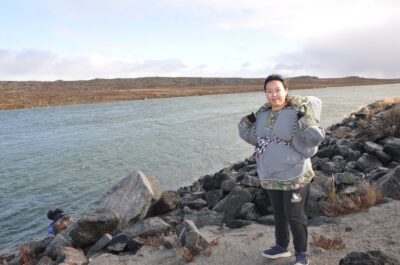Nunavik’s Inuit residents show resilience in the face of persistent water shortages
By Canadian Press on November 24, 2025.

PUVURNITUQ — In Quebec’s Nunavik region, it’s not unusual to run out of drinking water at home, or to have a full wastewater tank. But the Inuit residents demonstrate an impressive resilience to water shortages, with many adapting to the situation without complaint as they go about their lives in a remote region of Quebec dominated by the unique tundra landscape.
“I’m not stressed about it,” says Joshua Nathan Kettler, when asked about the constant water shortages. “We grew up with it, so you have to adapt to it. Down south … you can run water no problem, and everyone takes a shower every day. Up north, you have to consume and think.”
The 24-year-old Inuit resident of Inukjuak says he has to pick up his daughter at school about once a month due to a lack of water, and take time off work until the interruption is resolved. Kettler acknowledged that the situation isn’t fair.
“But I feel blessed to have our municipality constantly working and trying to keep on top of their game, it’s nice,” he said, adding, “I feel happy as is.”
It’s a similar story in Puvirnituq, where 79-year-old Marilyn Simpson lives with her partner Paulusi Angiyou as well as Angiyou’s son and his partner, Siasi Padlayat, and their baby. The young couple is expecting another child this winter.
“There’s always a lack of water, it doesn’t matter if it’s run by machine or by hand,” said Angiyou, 75, who lived in tents and igloos in his youth.
“We’ve lived here when there was no running water,” added Simpson. “We adapt better than some people in town.”
Manon Rancourt, a former coordinator at the Innulitsivik Health Centre, marvels at the residents’ determination. “Resilient – I think that’s the best way to describe them,” she said.
“It’s as if there are never any problems,” she added. The residents are resilient and accustomed to the situation, she said. “They’re not a people who complain.”
Padlayat gets a little more nervous when the water level in the reservoir gets low, since her young daughter recently stopped breastfeeding, and water is needed to prepare formula. “It’s different when we have a baby, it’s definitely a source of worry,” she said.
When the couple gets low on water, her partner fetches big jugfuls from the river, which the family boils.
Kettler does the same. “Worst case, if everything is out of service, we can go get water in the river,” he said. In the winter, he bores a hole in the ice to collect water, “like for ice fishing,” he says.
Inukjuak Mayor Bobby Epoo says attitudes toward water consumption vary. “Some households are very careful, will voluntarily limit their water use, and some don’t even care,” he said. He estimates that 40 per cent of the population are frustrated by the situation, 40 per cent are used to it, and 20 per cent “don’t give a damn.”
Faced with persistent shortages, residents have developed ways of managing their reservoirs. To avoid an overfull wastewater tank, Kettler sometimes unplugs the hose from his washing machine to collect the water in a container and dump it outside.
Simpson reuses some of her bathwater in her washing machine, which helps save drinking water.
The reasons that lead to water shortages can be very random, says Liv Larsen, coordinator of material resources for the Inuulitsivik Health Centre.
“It’s hard to put your finger on one thing and say, ‘OK, we’ll solve this problem,'” she said. “Everyone will have to pitch in.” She said the federal government should step in to improve airport runways, in order to ensure a smoother arrival of workers and supplies, while the province needs to prioritize essential services such as water access.
Nunavik must contend with conditions no other region has to deal with, according to Dr. Yassen Tcholakov, a public health physician and head of infectious diseases in Nunavik. “These are things where more intensive intervention, with more resources, could more quickly change the situation in Nunavik,” he said.
“There are capital investment plans, construction plans, and plans to expand (health clinics) in communities where the population has grown, but these are long-term plans … these aren’t things that will happen overnight.”
He says there’s still a lot of work that needs to be done with the communities and the province to find solutions that will allow Nunavik’s population to reach a level of health similar to that in the rest of Quebec.
This report by The Canadian Press was first published Nov. 24, 2025.
Katrine Desautels received the support of the Michener Foundation, which awarded her a Michener-Deacon Investigative Journalism fellowship in 2025 to report the impact of the lack of access to water in Nunavik’s Indigenous communities. This article is the fourth in a series of four reports.
Katrine Desautels, The Canadian Press
-25

